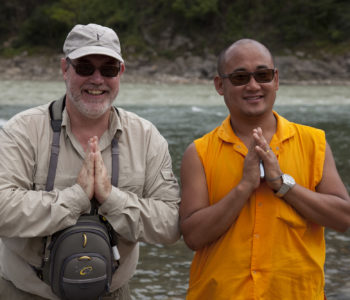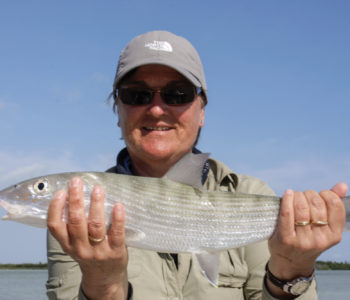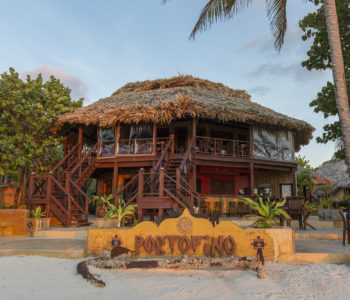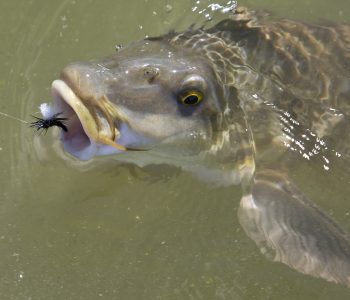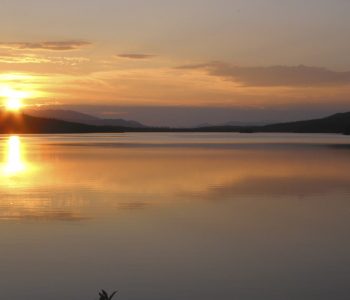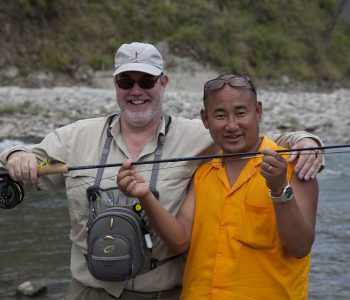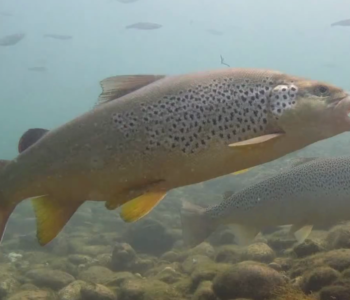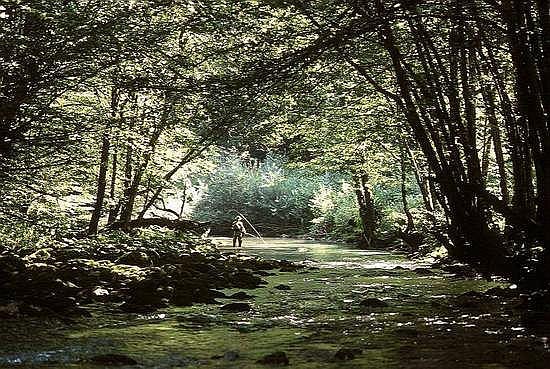
Sweet Surprise by Mislav Jukic
Most of the fishermen I know have a creek like this somewhere in their lives. It’s not big, it’s not great, it’s not famous, and therein lies its charm. It’s an ordinary trout and grayling stream, where fly fishing can be a casual affair, rather than “the adventure of a lifetime.” It’s the place where, for once, I feel like I’m at home.
I’m sure that even a guy who lives but a half a day from some of the best trout rivers in the world has a little creek like this tucked away somewhere. He can’t brag about it in the usual extravagant terms, but he still likes to show it off, as he may put it, to “the right people.”
My little creek is named Curak. I’ve lived within sight of it for a long time now, and fishing on it is always familiar and relaxing. Profound relaxation kicks in when you find yourself able to satisfy one of your more acute cravings. Like, for instance, the need to fly fish for trout and grayling in a stream, just about any time the mood strikes, and to occasionally even have some success at it.
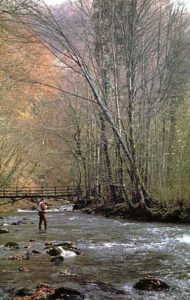 The day I bought this house on the creek (well, a ten minute drive from the creek actually, although it sounds better the other way) I knew that, in time, I would become deeply familiar with it, and that a lot of good things would flow from it.
The day I bought this house on the creek (well, a ten minute drive from the creek actually, although it sounds better the other way) I knew that, in time, I would become deeply familiar with it, and that a lot of good things would flow from it.
Curak Creek springs from underneath a high rock; from a spring named Zeleni Vir (Green Whirlpool) because of its color. Throughout almost its entire length, Curak flows through a beautiful wooded canyon. A part of the canyon is a special geomorphological reserve called Vrazji Prolaz (Devil’s Pass), where the high cliffs are separated no more than few meters from each other. There is also a cave named Muzeva Hiza. Curak Creek’s banks are covered with dense forest, and the fishing is particularly impressive. If one likes fishing on small streams, then Curak Creek is a real jewel; not to be missed. Because of the forest canopy, it is very good during the summer months, when thick shade and a light breeze, which often blows cool air from the stream surface, could mean difference between comfortable fishing and baking in the open. Fishing on Curak Creek is organized under the “catch & release” principle. Fishing is allowed with one fly rod and one artificial fly. Use of fishhooks without counter barbs is mandatory. Curak’s entire course is only six kilometers long, and then it flows into the Kupica River near the village of Isevnica. Although some parts of the river’s course are easily accessible from the forest road, most of the fishing waters can be reached only by walking through the forest.
One warm and bright morning in May, my friend Claudio from Italy and I decided to fish together on Curak Creek. Claudio definitely belongs in “the right people” category of fisherman, so I wanted to show him few secret spots loaded with big grayling. We left the car at the end of the forest road and started to walk upstream. We began to fish along the path, which mostly follows the stream, passing through the forest towards the spring. On Curak it can be particularly useful to fish using the so called “Czech nymphing” technique because of the relatively strong and fast current. That way you don’t have to do much false casting, thus avoiding getting snagged in the branches of nearby trees if you are not careful or delicate enough in presentation. But that day, Claudio and I decided to fish with dry flies because there were nice caddis flies hatching on the water., and the fish were picking them from the surface.

I tied one fly on the tippet that I had tied myself; a small elk-hair caddis, on a number 16 hook. Since there were no visible rises where I was standing, I started to search the water, which was, in that particular spot, dotted with large rocks. I drifted the fly past, or through, any good-looking spots where I thought that fish might be hidden.
I presented the fly in one calm little pool behind a rock. The fly floated there for only a few seconds, when suddenly a nice trout quickly rose from the bottom and grabbed the fly from the surface.
I gently set the hook, and felt a nice trembling in the rod while trout was running up and down, across the bottom of the stream. I slowly pulled the fish toward me, and finally I held a beautifully speckled wild brown trout in my dripping left hand. Carefully, I removed the hook and held the fish in the current, pointed upstream to regain its breath. Shortly, with a few quick flicks of its tail, the trout disappeared across the bottom.
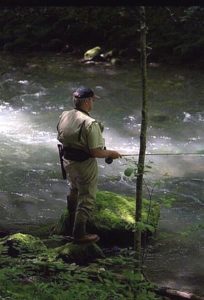 After that, I sat down in the grass on the bank, trying to attune myself with the surroundings, and to absorb as much of them as I could. The air was warm; filled with the scents of the fully blossoming forest. I could once again feel the life pulsating around me. The birds were chirping in the trees, and insects slowly danced across the water’s surface, warmed by the sun. I watched Claudio fishing some distance from me in a beautiful spot. The stream flowed slowly past him, as the sunlight, shining through the canopy of leaves, was chasing shadows around. Claudio was casting upstream as far as he could, using a side cast to avoid getting tangled in the branches. As the small elk-hair caddis floats toward him he strips in the excess line with his retrieving hand, thus allowing the fly to float naturally. In that way, he was constantly in contact with the fly. When the fly drifted past one large rock, it instantly disappeared in a splash of water, and Claudio was connected to what looked to be a nice sized fish. The rod worked nicely while the fish tried to break free. By the way the fish rolled in the water and tried to use the hydrodynamics to his benefit, I knew it was probably a beautiful big grayling. Claudio lowered himself on one knee while he gently removed the hook from grayling’s mouth, releasing it in the current. I watched how he managed to fool two more grayling and one brown trout shortly after.
After that, I sat down in the grass on the bank, trying to attune myself with the surroundings, and to absorb as much of them as I could. The air was warm; filled with the scents of the fully blossoming forest. I could once again feel the life pulsating around me. The birds were chirping in the trees, and insects slowly danced across the water’s surface, warmed by the sun. I watched Claudio fishing some distance from me in a beautiful spot. The stream flowed slowly past him, as the sunlight, shining through the canopy of leaves, was chasing shadows around. Claudio was casting upstream as far as he could, using a side cast to avoid getting tangled in the branches. As the small elk-hair caddis floats toward him he strips in the excess line with his retrieving hand, thus allowing the fly to float naturally. In that way, he was constantly in contact with the fly. When the fly drifted past one large rock, it instantly disappeared in a splash of water, and Claudio was connected to what looked to be a nice sized fish. The rod worked nicely while the fish tried to break free. By the way the fish rolled in the water and tried to use the hydrodynamics to his benefit, I knew it was probably a beautiful big grayling. Claudio lowered himself on one knee while he gently removed the hook from grayling’s mouth, releasing it in the current. I watched how he managed to fool two more grayling and one brown trout shortly after.
The grayling from Curak have a characteristic pinkish and red dorsal fin and tail. They are silver in appearance, fight fiercely, and are for me, the most beautiful of all fish. This type of grayling is typical for rivers associated with the Black Sea drainage basin, like the Kupa River, with tributaries in Croatia, and the Sava River, with tributaries in Slovenia. They can be found in the Soca River as well.
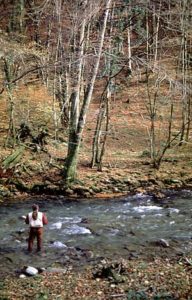 We fished our way upstream for two hours, and we caught few more nice fish along the way. Near the spring of Curak Creek is nice mountain cabin, where it is possible to rest and refresh for a while. It belongs to the Croatian Forest Company, and there is always someone in it. We managed to acquire two cold beers there, and rest in the shade near the confluence of a brook named Jasle and Curak Creek.
We fished our way upstream for two hours, and we caught few more nice fish along the way. Near the spring of Curak Creek is nice mountain cabin, where it is possible to rest and refresh for a while. It belongs to the Croatian Forest Company, and there is always someone in it. We managed to acquire two cold beers there, and rest in the shade near the confluence of a brook named Jasle and Curak Creek.
From the spot where we were resting, two paths separated; one leading uphill toward the spring of Curak Creek, named Zeleni Vir (Green Whirlpool), and other leading to a gorge named Vrazji Prolaz (Devil’s Pass), from which Jasle brook flows out and spills into Curak. Fishing further upstream is not allowed, so after a while we started to retrace our steps. On the way back toward the car we caught few more fish, so I suggested that we try to fish further downstream near the village of Lozac. There were a couple of nice spots there, especially for dry fly fishing.
We started to fish again near the small bridge in the village of Lozac. The village is actually one solitary household, with a few barns. It is located right on the opposite bank from where we started to fish downstream. All rivers and waters in Croatia have public access, so we didn’t worry about trespassing on private property. All you have to do is to obey the laws, and behave properly and quietly on the stream. After all, that is what fly fishing is all about for me.
Almost instantly, we observed how fish were rising all everywhere. We separated, and I quickly tied on a CDC dry fly and cast it in the vicinity of the last rise I saw. The same moment that the fly settled down on the surface, it was struck fiercely by the fish. I gently set the hook, and after a couple of nice pulls, the fish started to jump from the water in an attempt to break the tippet. Soon I landed a nice rainbow trout, and I saw how Claudio successfully played another one further downstream. I was surprised because rainbow trout don’t live in Curak, and as far as I knew, people from the local fishing society never attempted to stock them. To my further surprise, in the next two hours, we caught so many rainbows that we finally lost count.
A little later, while slowly walking back toward Claudio, I quietly settled higher up behind him on the bank, leaning my back against a three trunk.
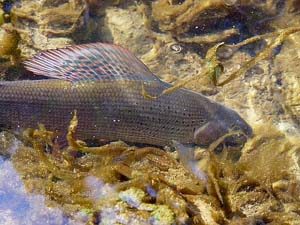 It was so nice to watch him fishing; almost like watching a movie. There he was, standing in the stream, a look of contented concentration on his face, casting upstream and retrieving the line with a rhythm that exactly matched the speed of the current. I watched intently how the small dry fly naturally drifted in the current, and almost every few casts a trout would rise to the fly. Claudio slowly played the fish he hooked, and enjoyed every minute of the process. I was puzzled by the mystery of rainbow trout we were catching, until I later learned the answer. A man who owns a house near the creek bank in Lozac had built a small pool where he stocked a hundred kilos of rainbow trout for his own use (I presume for food). The pool and creek are connected, and the trout inadvertently managed to escape into the creek. Although I sympathize with the owner, through his carelessness, he really provided a nice surprise for us fishermen. As the old proverb says: “One man’s loss is another man’s gain.”
It was so nice to watch him fishing; almost like watching a movie. There he was, standing in the stream, a look of contented concentration on his face, casting upstream and retrieving the line with a rhythm that exactly matched the speed of the current. I watched intently how the small dry fly naturally drifted in the current, and almost every few casts a trout would rise to the fly. Claudio slowly played the fish he hooked, and enjoyed every minute of the process. I was puzzled by the mystery of rainbow trout we were catching, until I later learned the answer. A man who owns a house near the creek bank in Lozac had built a small pool where he stocked a hundred kilos of rainbow trout for his own use (I presume for food). The pool and creek are connected, and the trout inadvertently managed to escape into the creek. Although I sympathize with the owner, through his carelessness, he really provided a nice surprise for us fishermen. As the old proverb says: “One man’s loss is another man’s gain.”
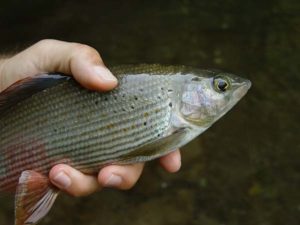
As the sun was slowly fading in the western sky, we walked with tired steps down the road toward the car, discussing the events of a day which had turned out to be so successful. In a way, I feel that I will always have a special bond with Curak Creek, if for no other reason than because I have learned a number of things about fly fishing there. They are the unlikely sort of things you learn when it doesn’t matter if you catch a fish today or not, simply because you have all the time in the world. These things, call them tactics or approaches, work on other streams too, but never quite as well.
Being so familiar with the stream gives me the luxury to absorb the sights and sounds of nature in its full extent; just to simply sit and rest, to lean my back against a three trunk and take it easy.
I know where the fish are, including some secret spots know only to me; spots well hidden between the more obvious ones that any competent fly fisher would wade right to on his first visit. Sometimes being a local fellow has its advantages!

If you want to know more about Mislav, have a look at his website at:
http://www.kupa-flyfishing.com/
